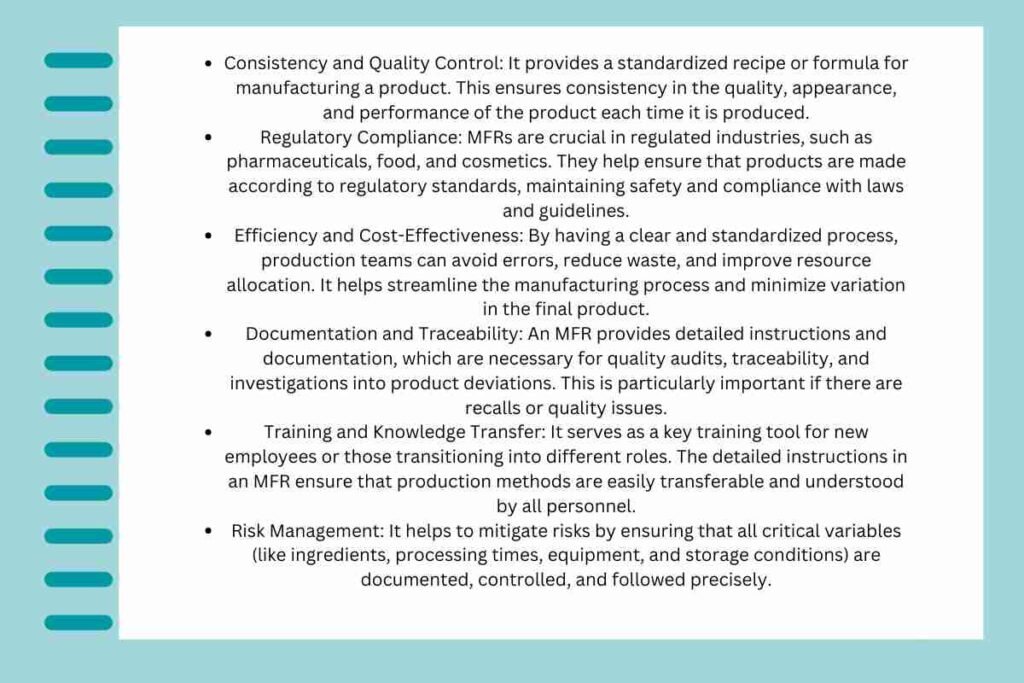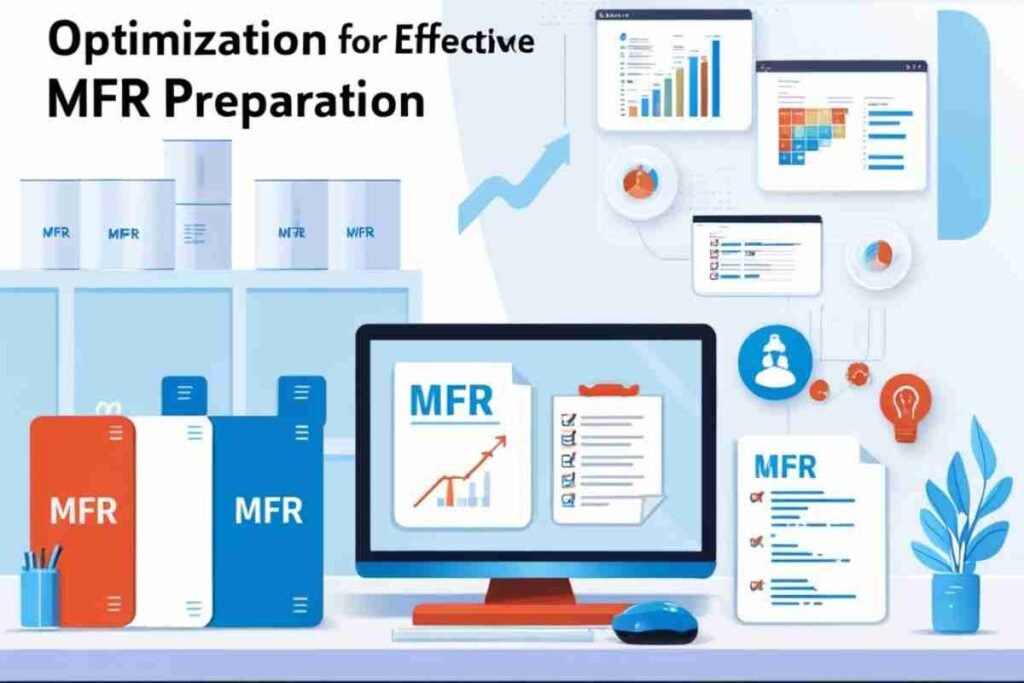A Master Formula Record (MFR) is an essential document used in pharmaceutical manufacturing that outlines all the necessary details for producing a specific product.
It acts as a blueprint for the entire production process, ensuring that every batch of medicine is produced consistently, safely, and in compliance with regulatory standards.
In this guide, we’ll break down the preparation of a Master Formula Record, step-by-step, and explain why it’s critical for efficient and compliant pharmaceutical manufacturing.
Why is a Master Formula Record Important?

The Master Formula Record serves multiple crucial roles in pharmaceutical production:
- Consistency: It ensures that each batch is manufactured according to the exact specifications, which is essential for maintaining product quality.
- Regulatory Compliance: A well-prepared MFR helps ensure that production adheres to Good Manufacturing Practices (GMP) and other industry regulations.
- Quality Control: It provides clear instructions for quality control teams to follow during production, preventing errors and ensuring product safety.
- Training: New employees can use the MFR to understand the correct procedures and the rationale behind each step of the production process.
Step-by-Step Guide to Preparing a Master Formula Record
Creating a Master Formula Record may seem like a complicated task, but breaking it down into manageable steps can simplify the process. Here’s how to do it:
Define Product Information
Begin by including basic information about the product. This should include:
- Product name
- Dosage form (tablet, capsule, liquid, etc.)
- Strength (e.g., 100 mg per tablet)
- Shelf life and storage conditions
List Ingredients and Quantities
Next, list all the ingredients needed for the formulation, including active pharmaceutical ingredients (APIs) and excipients. Specify the required amounts for each ingredient and the unit of measurement.
Detail the Manufacturing Process
Provide a detailed description of the entire manufacturing process. This includes:
- Preparation of ingredients (e.g., weighing, mixing)
- Specific equipment needed
- Step-by-step instructions on how each ingredient should be processed
Record In-Process Control Tests
It is essential to include instructions for in-process control tests. These tests help monitor the quality of the product throughout the manufacturing process. Some common tests might include:
- pH levels
- Weight variation
- Disintegration time
Packaging and Labeling
Specify how the product should be packaged and labeled. This ensures compliance with regulatory guidelines and proper identification for customers and healthcare providers.
Regulatory Compliance for MFR Preparation

When preparing a Master Formula Record, it’s important to adhere to various regulatory standards to ensure the document is both accurate and compliant. Some key regulations include:
Good Manufacturing Practices (GMP)
GMP guidelines are the foundation for creating a Master Formula Record. These practices outline the standards for quality production and control, ensuring that pharmaceutical products are consistently produced and controlled according to quality standards.
ICH Guidelines
The International Council for Harmonisation (ICH) provides global standards for the pharmaceutical industry. The MFR should comply with ICH guidelines to ensure safety, efficacy, and quality in drug production.
Real-Life Example of an Effective Master Formula Record
In a leading pharmaceutical company, the use of a standardized MFR template helped streamline production. The template included clear instructions for each manufacturing stage and automated batch calculations.
As a result, the company reduced production errors by 25% and improved compliance with regulatory inspections.
Common Mistakes in MFR Preparation and How to Avoid Them
Although preparing a Master Formula Record may seem straightforward, there are common mistakes that can undermine the effectiveness of the document. Here’s how to avoid them:
Missing or Incorrect Information
Ensure that all details, from ingredients to process steps, are accurate and complete. Double-check quantities, batch sizes, and any regulatory requirements.
Failure to Update
As formulas and regulations change, MFRs need to be updated regularly. Failing to keep the MFR current can lead to non-compliance or quality issues.
Lack of Clarity
The MFR should be clear and easy to follow. Avoid overly technical jargon that may confuse the production team. Make sure all instructions are straightforward and unambiguous.
Inadequate Testing Procedures
Ensure that your in-process testing is thorough and covers all necessary parameters. Missing tests can lead to unapproved batches.
Optimization Tips for Effective MFR Preparation

Preparing a Master Formula Record can be a time-consuming process, but there are ways to make it more efficient:
- Use Templates: Many companies use pre-designed templates for creating MFRs. These templates can save time and ensure consistency across records.
- Automate Calculations: Automating ingredient quantities and batch calculations can reduce human error and save time.
- Regular Training: Make sure that everyone involved in the process is trained regularly. This will help avoid mistakes and ensure smooth production.
Conclusion
A Master Formula Record (MFR) is an indispensable tool for pharmaceutical manufacturers. It ensures consistency, quality, and regulatory compliance throughout the production process.
By following a clear, structured approach to MFR preparation, companies can avoid common pitfalls and improve efficiency. Additionally, an accurate MFR helps in meeting stringent regulatory requirements and enhances the traceability of the manufacturing process.
Regular updates and clear documentation also foster better communication across departments, reducing errors and increasing productivity. Ultimately, MFRs play a vital role in ensuring the safety and efficacy of pharmaceutical products.
FAQs
What is a Master Formula Record?
A Master Formula Record (MFR) is a comprehensive document that outlines the complete manufacturing process, including ingredients, instructions, and specifications for producing a pharmaceutical product.
Why is the Master Formula Record important in pharmaceutical production?
The MFR ensures consistency in production, helps meet regulatory standards, and provides clear instructions for manufacturing processes, reducing the risk of errors.
What information is included in a Master Formula Record?
A typical MFR includes product details, ingredient quantities, detailed manufacturing instructions, packaging and labeling requirements, and in-process control tests.
How often should the Master Formula Record be updated?
The MFR should be updated whenever there are changes to the formulation, regulatory standards, or manufacturing process to maintain compliance and accuracy.
What are some common mistakes in MFR preparation?
Common mistakes include missing or incorrect information, failure to update the MFR, lack of clarity in instructions, and inadequate in-process testing.
How can I optimize the MFR preparation process?
You can optimize the process by using templates, automating calculations, and ensuring regular training for all staff involved in the preparation process.
Who is responsible for creating the Master Formula Record?
Typically, the responsibility lies with the formulation team, with input from quality control, production, and regulatory affairs teams.
How does a Master Formula Record help in regulatory compliance?
The MFR helps ensure that the manufacturing process complies with industry regulations like GMP and ICH guidelines, making it a critical document for meeting legal requirements.